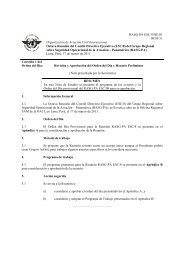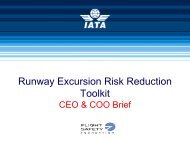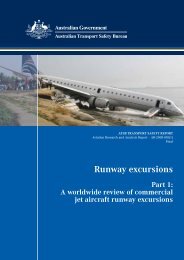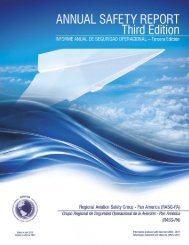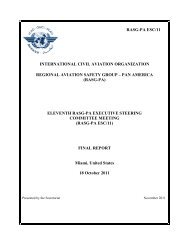Runway Excursion Prevention Air Carrier Self Audit Checklist
Runway Excursion Prevention Air Carrier Self Audit Checklist
Runway Excursion Prevention Air Carrier Self Audit Checklist
Create successful ePaper yourself
Turn your PDF publications into a flip-book with our unique Google optimized e-Paper software.
<strong>Runway</strong> <strong>Excursion</strong> <strong>Prevention</strong><strong>Air</strong> <strong>Carrier</strong> <strong>Self</strong> <strong>Audit</strong> <strong>Checklist</strong>PurposeThe Flight Safety Foundation (FSF) Reducing the Risk of <strong>Runway</strong> <strong>Excursion</strong>s reportidentifies a number of different risks, and includes recommended mitigations. This“<strong>Self</strong> <strong>Audit</strong> <strong>Checklist</strong>” is designed so that operators can evaluate their own trainingand operational policies, procedures and programs to ensure that they haveminimized these identified risks.This self audit checklist is not intended to comprehensively cover every conceivablerisk factor that may result in a runway excursion, nor is it intended to overrideregulatory guidance or manufacturer’s recommended practices. <strong>Air</strong> carriers areencouraged to enhance this checklist for their own use.GeneralRisk Factor to be analyzed or self audit questionto be answered• Do you have a process to actively monitorrisk during takeoffs and landings (such as apilot incident reporting system and/or a FlightData Analysis (FDA) program? Note: refer to the Risk Monitoring section ofthis checklist for more detail on FDAmonitoringAnswer Yes NoStatus ofimplementation• Do your training programs address the factthat the presence of more than one runwayexcursion risk factor (i.e., contaminatedrunway, high crosswinds, MEL, etc) increasesthe overall risk? Yes No• Do you have a training program for pilots,dispatchers, and load planners for takeoff andlanding performance calculations? Yes NoTAKEOFF EXCURSION RISKSThe runway excursion report identified four areas of risk that contribute to themajority of takeoff runway excursions: takeoff and landing performancecalculations, proper Rejected Takeoff (RTO) accomplishment, aircraft directionalcontrol during takeoff, and proper aircraft loading.© International <strong>Air</strong> Transport Association 2009. All Rights Reserved. 1 <strong>Air</strong> <strong>Carrier</strong> <strong>Self</strong> <strong>Audit</strong> <strong>Checklist</strong>Extract from the <strong>Runway</strong> <strong>Excursion</strong> Risk Reduction (RERR) ToolkitFirst Edition 2009 and subject the disclaimer contained therein.
Takeoff Performance Policies, Calculations, and TrainingRisk Factor to be analyzed or self audit questionto be answeredAnswerStatus ofimplementation• Do you have a procedure that requiresperformance calculations for each takeoff,and each specific runway? Yes No• Do these training programs address all of thetakeoff performance factors addressed by theaircraft manufacturer that affect takeoffperformance?o Does your training program specificallyaddress the effects of runwaycontamination (water, snow, ice, etc) onperformance?o Does your training program specificallyaddress effects of inoperative aircraftequipment (i.e., brakes, anti-skid, enginereversers, spoilers, etc) on performance? Yes No Yes No Yes No• Do these training programs identifyoperational limitations (crosswinds, tailwinds,wet runway limits, runway length, takeoffswith wind shear present, etc) for each aircrafttype in accordance with the manufacturer’sguidance? Yes No• Does your performance training programinclude a discussion of the following:o How takeoff distance is calculatedo Balanced field lengtho Effects of MELs on takeoff performanceand RTO performanceo If reverse thrust is used in computing RTOdistanceo Assumptions of pilot reaction time duringRTO’s Yes No Yes No Yes No Yes No Yes No Yes No© International <strong>Air</strong> Transport Association 2009. All Rights Reserved.Extract from the <strong>Runway</strong> <strong>Excursion</strong> Risk Reduction (RERR) Toolkit2 <strong>Air</strong> <strong>Carrier</strong> <strong>Self</strong> <strong>Audit</strong> <strong>Checklist</strong>First Edition 2009 and subject the disclaimer contained therein.
Risk Factor to be analyzed or self audit questionto be answered• Do you have a process to identify criticalrunways?• Have you defined a critical runway for eachaircraft type with regard to the length ofrunway required, field elevation, obstacles,etc?Answer Yes No Yes NoStatus ofimplementation• Do you monitor “non-critical” runways forchanges that could cause them to becomecritical? (i.e., runway construction,contaminated runways, new obstacles, etc) Yes NoRejected Takeoff (RTO) policies, procedures, and training• Do your operational procedures define eventsfor when an RTO should be performed (inaccordance with the aircraft manufacturer’srecommendations)?• Does your training program includediscussions as to when it is appropriate toperform an RTO, and when an RTO is not thebest choice (i.e., the go/no-go decision)?• Does your training program discuss when anRTO must be performed for engine failures atspeeds well below V1?• Does your training program discuss theincreased risk of an RTO as aircraft speedapproaches V1 (especially at high takeoffweights), and the appropriateness of an RTOdecision?• Does this training program address theamount of runway required for an RTO atairspeeds greater than V1, and the caseswhen an RTO above V1 will likely result in arunway excursion?• Does your simulator training program include:o Practice of RTOs, and the appropriate useof all available aircraft capabilities (brakes,spoilers, auto brakes, reverse thrust, etc) Yes No Yes No Yes No Yes No Yes No Yes No© International <strong>Air</strong> Transport Association 2009. All Rights Reserved. 3 <strong>Air</strong> <strong>Carrier</strong> <strong>Self</strong> <strong>Audit</strong> <strong>Checklist</strong>Extract from the <strong>Runway</strong> <strong>Excursion</strong> Risk Reduction (RERR) ToolkitFirst Edition 2009 and subject the disclaimer contained therein.
Risk Factor to be analyzed or self audit questionto be answered• Does your simulator training program providefor:o High speed RTO decision making (below,at, and above V1)?o Does your training program addressaircraft control and the go- no-go decisionfollowing a takeoff tire failure?o Other mechanical failures that may requirean RTO (ie, hydraulic failures, loud noises,vibrations, master warning lights, etc)• Training for mechanical failures that do notrequire an RTO (minor system failures, cabininterphone calls, etc)Answer Yes No Yes No Yes No Yes NoStatus ofimplementationDirectional control during takeoff training• Does your training program addressdirectional control issues during crosswindand contaminated runway takeoffs? (i.e., theappropriate use of aircraft controls such asflight controls, the tiller, etc)?• Does your training program address theproblem of directional control during a lowspeed RTO following an engine failure?o Does your training program discussminimum control speed (Vmcg, asprovided by the aircraft manufacturer)following an engine failure?o Does your training program providesimulator training for low speed RTO’s(less than Vmcg), highlighting therequirement for an immediate reduction inthrust on the remaining engine(s)?• Does your training program address CRMand adherence to SOP’s during an RTO?o Do your procedures and training programsaddress RTO procedures when the co-pilotis making the takeoff?o Do you have a clear operational policy asto who makes the “go, or no-go” decisionduring each takeoff (i.e., does the captainalways decide, or is the decision made bythe flying pilot)? Yes No Yes No Yes No Yes No Yes No Yes No Yes No© International <strong>Air</strong> Transport Association 2009. All Rights Reserved. 4 <strong>Air</strong> <strong>Carrier</strong> <strong>Self</strong> <strong>Audit</strong> <strong>Checklist</strong>Extract from the <strong>Runway</strong> <strong>Excursion</strong> Risk Reduction (RERR) ToolkitFirst Edition 2009 and subject the disclaimer contained therein.
<strong>Air</strong>craft LoadingRisk Factor to be analyzed or self audit questionto be answeredAnswerStatus ofimplementation• Do you have written procedures to ensurethat aircraft are loaded properly and in astandardized manner? Yes No• Do you have a process to measurecompliance with aircraft loading procedures?o Do you monitor ramp crew loading (i.e., viaaudits of loads, reports of errors, etc)o Do you have a process for flight crews toreport load errors, and pass on theseerrors to your ground operationsdepartment?o Do you have a process for ramp crews toreport load errors (ie, found on arrival)?o Do you routinely report load proceduralerrors and compliance to senior managersin your ground operations organization? Yes No Yes No Yes No Yes No Yes No• Do you have written procedures to ensurethat the flight crew properly configures thecockpit based on aircraft load information(i.e., flap, trim, airspeed and thrust settings?o Are both (all) pilot involved in verifyingproper cockpit configuration?o Do you ensure that all critical FlightManagementComputer/System(FMC/FMS) load data (aircraft weights,airspeeds, thrust settings, etc) are verifiedby both (all) pilots? Yes No Yes No Yes No© International <strong>Air</strong> Transport Association 2009. All Rights Reserved. 5 <strong>Air</strong> <strong>Carrier</strong> <strong>Self</strong> <strong>Audit</strong> <strong>Checklist</strong>Extract from the <strong>Runway</strong> <strong>Excursion</strong> Risk Reduction (RERR) ToolkitFirst Edition 2009 and subject the disclaimer contained therein.
LANDING EXCURSION RISKSThe runway excursion report identified four areas of risk that contribute to themajority of landing runway excursions: un-stabilized approaches, the go-arounddecision, abnormal touchdowns and landings on contaminated runways.Landing Performance Policies, Calculations, and TrainingRisk Factor to be analyzed or self audit questionto be answeredAnswerStatus ofimplementation• Do you have a process to ensure that pilotsare informed of the current field conditions,including runway contaminants, winds, etc? Yes No• Do you have a policy that pilots must checklanding performance (distance calculation,etc) against runway length on every landing?• Is the above information shared among thecrew members? (i.e., do you require alanding briefing)• Do you use manufacturer authorized landingperformance charts?• Is your performance data presented on easyto-usecockpit material?o Do you audit your aircraft to ensureperformance data material is current? Yes No Yes No Yes No Yes No Yes NoUn-stabilized Approach• Do you have an operation policy in yourmanual that requires a stabilized approach? Yes No© International <strong>Air</strong> Transport Association 2009. All Rights Reserved. 6 <strong>Air</strong> <strong>Carrier</strong> <strong>Self</strong> <strong>Audit</strong> <strong>Checklist</strong>Extract from the <strong>Runway</strong> <strong>Excursion</strong> Risk Reduction (RERR) ToolkitFirst Edition 2009 and subject the disclaimer contained therein.
Risk Factor to be analyzed or self audit questionto be answered• Do you have specific criteria defined for astabilized approach?o Do your criteria require that the aircraft bestabilized by a specific altitude above therunway?o Do your criteria require that the landingconfiguration be established by a specificaltitude?Answer Yes No Yes No Yes NoStatus ofimplementationoDoes it include limits or errors in approachspeed, specific airspeeds, configurations,thrust settings and glide path criteria? Yes No• Does your training program include examplesof accidents that have occurred because ofun-stabilized approaches?• Does your check standard make sure that theability of pilots to make a stabilized approachwill be checked? Yes No Yes NoGo-around Decision• Do you have a written operational policy thatyou must execute go-around in un-stabilizedconditions?• Do you have specific criteria that require ago-around?• Do you have a policy that a go-around will notbe punished or even questioned bymanagement (i.e., non punitiveenvironment)?• Does your CRM course addresses theimportance of assertion (especially by the copilotor other crewmembers) when theapproach is not stabilized?• Are your co-pilots trained to call out wheneverhe or she detects un-stabilized conditions? Yes No Yes No Yes No Yes No Yes No© International <strong>Air</strong> Transport Association 2009. All Rights Reserved. 7 <strong>Air</strong> <strong>Carrier</strong> <strong>Self</strong> <strong>Audit</strong> <strong>Checklist</strong>Extract from the <strong>Runway</strong> <strong>Excursion</strong> Risk Reduction (RERR) ToolkitFirst Edition 2009 and subject the disclaimer contained therein.
Risk Factor to be analyzed or self audit questionto be answeredAsymmetrical thrust• Do you have a procedure to make suredeceleration devices (speed brakes,symmetry thrust) are deployed properly (i.e.call outs by monitoring pilots, etc)?Answer Yes NoStatus ofimplementationo Do you have an operational procedure forasymmetrical condition, and do you trainyour pilots to follow SOP? Yes Noo Do you use reverse thrust in yourcontaminated runway stoppingperformance calculations? Yes No• If yes, do you have a contingencyprocedure if a thrust reverserfailure occurs? Yes No© International <strong>Air</strong> Transport Association 2009. All Rights Reserved. 9 <strong>Air</strong> <strong>Carrier</strong> <strong>Self</strong> <strong>Audit</strong> <strong>Checklist</strong>Extract from the <strong>Runway</strong> <strong>Excursion</strong> Risk Reduction (RERR) ToolkitFirst Edition 2009 and subject the disclaimer contained therein.
FLIGHT DATA ANALYSIS (FDA) or FLIGHT OPERATIONS QUALITY ASSURANCE(FOQA) RISK MONITOR PROGRAM SELF ASSESSMENTThis section of the self audit checklist provides air carriers with some of the bestpractices used in the industry in monitoring risk of runway excursions via FDA. Itshould be noted that many carriers select a sub-set of these specific events tomonitor, and that there is no requirement for an FDA program to monitor 100% ofthese risk factors.Risk Factor to be analyzed or self audit questionto be answeredAnswerStatus ofimplementation• Do you have a FDA (or FOQA) program?• If no, the remainder of this checklist is notapplicable. Yes No Yes No• Is data from your FDA program routinelyreviewed by senior management?• Do you set goals for continuous improvementusing FDA data (i.e., a 5% improvement ineach category)? Yes No Yes No• Do you use your FDA program to increaseyour oversight and monitor performance atcritical airports? Examples might be usingFDA to monitor:o thrust settings during takeoffs from shortrunwayso touchdown point and braking/spoiler/engine reverse use on landing at shortrunways• Do you include FDA data in your aircraftmaintenance program? Examples might beusing FDA data to monitor:o Low speed engine reverser use (resultingin potential FOD damage)o Hard landings (resulting in potentiallanding gear damage)o Excessive brake use (indicating potentialerrors in landing distance calculations) Yes No Yes No© International <strong>Air</strong> Transport Association 2009. All Rights Reserved. 10 <strong>Air</strong> <strong>Carrier</strong> <strong>Self</strong> <strong>Audit</strong> <strong>Checklist</strong>Extract from the <strong>Runway</strong> <strong>Excursion</strong> Risk Reduction (RERR) ToolkitFirst Edition 2009 and subject the disclaimer contained therein.
Takeoff FDA MonitoringDoes your FDA/FOQA program monitor the following occurrences:Risk Factor to be analyzed or self audit questionto be answered• Allowable flap settings and attempted no flaptakeoffs?Answer Yes NoStatus ofimplementation• Takeoff warning (i.e., configuration)occurrences? Yes No• Pitch angle (tail strike protection) on takeoff?• Thrust settings, or asymmetric thrustoccurrences?• Inappropriate flight control inputs (i.e., roll orpitch control inputs, high speed steering tiller,inadvertent brake applications, dual pilotinputs etc)• Rejected takeoff occurrences? Yes No Yes No Yes No Yes NoLanding FDA MonitoringDoes your FDA/FOQA program monitor the following occurrences:• Unstable approaches? Yes No• Go-arounds from unstable approaches? Yes No• Correct selection of landing flaps? Yes No• Late runway changes (or excessive bankangles near the ground)? Yes No• Excessive tailwind during final approach? Yes No• Excessive airspeed at touchdown? Yes No© International <strong>Air</strong> Transport Association 2009. All Rights Reserved. 11 <strong>Air</strong> <strong>Carrier</strong> <strong>Self</strong> <strong>Audit</strong> <strong>Checklist</strong>Extract from the <strong>Runway</strong> <strong>Excursion</strong> Risk Reduction (RERR) ToolkitFirst Edition 2009 and subject the disclaimer contained therein.
Risk Factor to be analyzed or self audit questionto be answered• Touchdown point (also known as deeplandings) monitoring (i.e., where on therunway the aircraft touches down)?Answer Yes NoStatus ofimplementation• Inappropriate pitch attitude at touchdown(i.e., tailstrike protection or very low attitudetouchdowns)? Yes No• Overweight landings? Yes No• Hard landings? Yes No• Nose wheel first touchdown events? Yes No• Use of reverse thrust? Yes No• Use of automatic/manual ground spoilers? Yes No• Use of normal and/or auto-braking? Yes No• High runway turnoff speed (especially onnon-high speed turnoffs)? Yes No© International <strong>Air</strong> Transport Association 2009. All Rights Reserved. 12 <strong>Air</strong> <strong>Carrier</strong> <strong>Self</strong> <strong>Audit</strong> <strong>Checklist</strong>Extract from the <strong>Runway</strong> <strong>Excursion</strong> Risk Reduction (RERR) ToolkitFirst Edition 2009 and subject the disclaimer contained therein.



